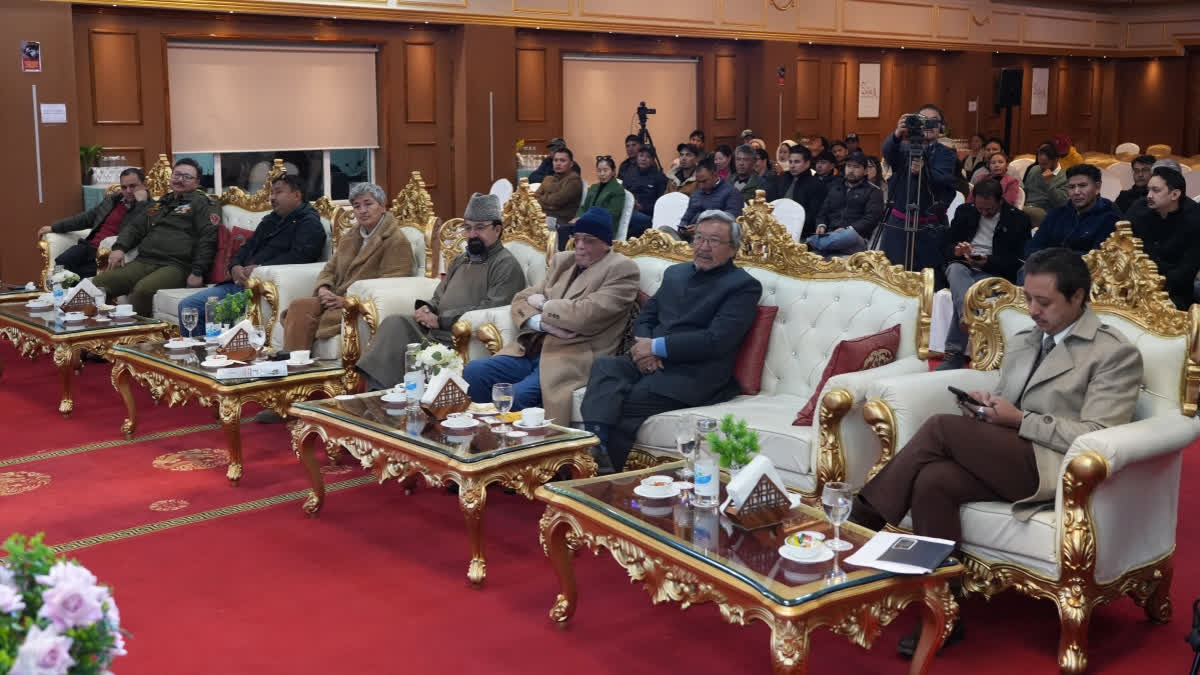Leh (Ladakh): A short film and documentary screening festival, organised in collaboration between the Department of Information and Public Relations and the Film & Television Federation of Ladakh, took place on Wednesday, November 13, in Leh. The festival aimed to offer a platform for filmmakers to reach a broader audience and discuss the growth of Ladakhi cinema and its potential on the international stage. Additionally, film screenings and interactive sessions were also held during the festival.
Dr Mohd Jaffer Akhoon, Chief Executive Councillor, LAHDC, Kargil was the chief guest and he highlighted the potential of Ladakhi filmmakers and the scenic locations in Ladakh, such as Suru Valley, as ideal spots for film shoots. Besides, he added, "Kargil is the best place for story writers, poets and filmmakers as mentioned by the Lt. Governor of Ladakh."
Padma Angmo, Commissioner/Secretary of Social Welfare & Tribal Affairs, UT Ladakh, was the guest of honour and praised Ladakhi filmmakers for their storytelling talent. She shared, "Filmmakers from Ladakh have telling brilliant stories over the years. Ladakh itself is a vast, creative landscape. Everything shot here has a unique beauty, and for audiences outside Ladakh, every frame tells a story. We need to encourage our filmmakers to create narratives that resonate with a broader audience, as there are so many stories here waiting to be told."
Earlier, in his opening address, Imteeaz Kacho, Joint Director of Information & Public Relations said, "In terms of potential, our filmmakers are next to none and deserve all the encouragement as well as government benefits to take bigger strides with their quest towards making Ladakh a crucial hub for filmmaking and towards taking Ladakhi cinema to different platforms in the entire world."
Mohammad Imran, an indigenous wildlife filmmaker, director, and conservationist from Ladakh shared about his documentary Shan- Spirit Of The High Mountains, which follows a female snow leopard and three generations of her cubs. He said, "We spent six years tracking them, and the documentary is complete. With Shan, we aimed to inspire, educate, and encourage the local communities. In 2022, we screened the film in various villages, schools, colleges, and universities and received positive feedback. Many young people here are now interested in exploring this field, but it's a tough, challenging profession. Equipment is expensive, there are no film schools in the region, and the harsh weather and terrain demand huge effort."
Imran expressed pride in creating Ladakh's first wildlife documentary with his team and said they are ready to showcase it internationally. "Ladakh has significant potential in wildlife filmmaking. Major productions and channels have already made national and international films here. In the future, this will support conservation efforts and positively impact tourism, as many wildlife photographers and filmmakers are eager to come to Ladakh to work on new projects. However, the lack of local crew means teams often bring people from outside, which doesn't benefit the locals. More Ladakhis should explore this field. Beyond tourism, there should also be contributions toward wildlife conservation," he said.
He added, "Platforms like this are vital for advancing our work. Festivals showcasing local films are needed to support emerging filmmakers, and government support through subsidies and schemes would further enable us to share our stories on both national and international stages in the coming years."
Tsering Lhanzes, an illustrator and animation filmmaker, shared about her short film Taar, which was based in Zanskar and screened last year as well, receiving positive feedback. She stated, "This field is still new to many people here, but as more aspects of life - education, entertainment, and daily activities - shift to digital mediums, animation is becoming essential. Animation plays a crucial role in video production, and I believe there's immense potential for it in Ladakh's future."
She continued, "So far, I've created three short films including Bungbu Palay, Rebo, and Taar, and they've been screened internationally as well. However, even if films are made, they need platforms like these to reach audiences. These festivals are important for filmmakers and producers to interact, showcase their work, and foster film appreciation. Without such events, these connections rarely happen." Reflecting on her journey, she added, "I've been making films for the last two years, and seeing them reach audiences has been incredibly rewarding."
Tsering Motup Chospa, a filmmaker from Ladakh, spoke about the impact of film festivals and platforms for local filmmakers. "These platforms allow Ladakhi filmmakers to connect with established directors, watch their films, and gain insights on techniques, shot composition, and storytelling ideas. Ladakh is a uniquely cinematic place in India, with distinct seasons - from snowfall in winter to scenic spots like Pangong and Nubra. Many Bollywood and Hollywood films have been shot here," he shared.
Reflecting on the evolving film scene, he added that with the transition of Ladakh to a Union Territory, young filmmakers now receive increased support and training opportunities, propelling them toward international recognition. Many emerging talents are learning at top film institutes, and Ladakh is poised to become a significant name in the film industry.
READ MORE
- Swatantrya Veer Savarkar to Open IFFI 2024; Kalki 2898 AD and 12th Fail among Mainstream Films to Be Featured
- Nayanthara Documentary Trailer: 'She Would've Dumped Vignesh Shivan If She Saw Him...' Nelson Dilipkumar Spills the Beans
- Kannada Short Film Sunflowers Were The First Ones To Know Qualifies For 2025 Oscars



